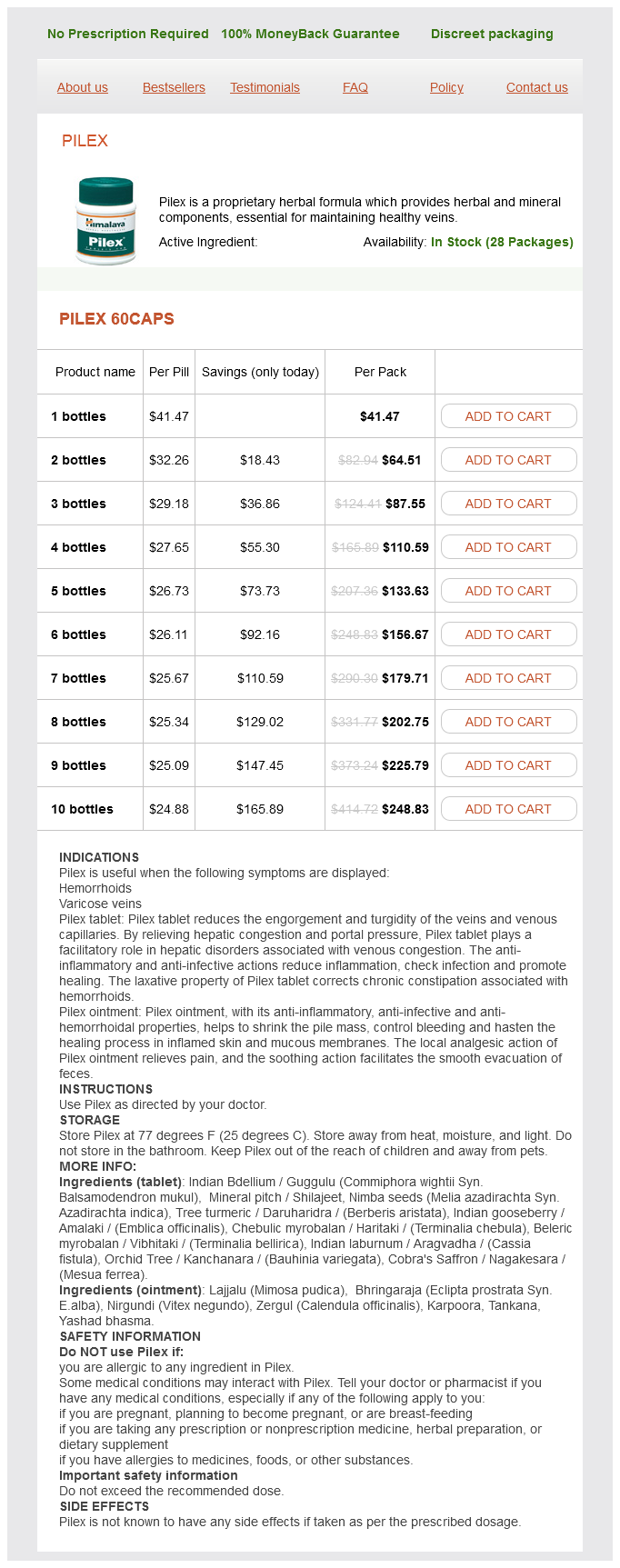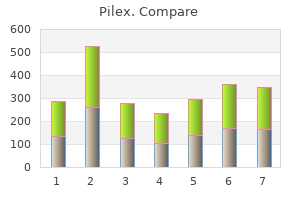Pilex

"Discount 60 caps pilex otc, prostate cancer keytruda".
M. Grompel, M.B. B.CH., M.B.B.Ch., Ph.D.
Assistant Professor, University of Illinois at Urbana-Champaign Carle Illinois College of Medicine
Dust is injected into the atmosphere by the parameterizatios of two processes: wind stress and convection mens health week pilex 60 caps online. The wind stress for the dust lifting mens health magazine australia purchase pilex 60 caps mastercard, is defined as follows: Where is the atmospheric density mens health vintage t-shirt cheap 60caps pilex amex, (1) is the wind velocity at the lowest layer of atmosphere (z1~50 m height) prostate cancer lymph nodes 60 caps pilex fast delivery, 0 is the surface roughness [20], and k = 0. The dust flux from the surface due to small-scale convective motions (dust devil), (in kg m-2 s-1), is defined as follows [11], = max[(1 -), 0], = max 2. Dust is assumed to be able to lift from the ground infinitely, and no dust lift occurs from the seasonal polar caps. The lifting by wind stress tends to occur on slopes, especially around the mountains (Olympus and Elysium) and northern edge of the Hellas Basin. The impact of dust in the atmosphere of Mars on human exploration is a multifaceted problem, including (1) the impact of Mars atmospheric dust on human health, (2) the impact of Mars atmospheric dust on surface systems. For example, Mars Pathfinder measurements established that chromium is present in Mars soil. Chromium contained in naturally occurring geologic materials is primarily in a trivalent state (a +3 ion), which is a stable form of chromium and minimally toxic to humans. If even a modest fraction of the chromium present in the Martian soil and airborne dust is hexavalent chromium (more than 150 parts per million), it would pose a serious health threat to astronauts operating on the surface of Mars. This implies that both the soil and airborne dust might be acidic, which could pose a hazard if they are introduced into an astronaut habitat. When inhaled by astronauts, acidic soil and dust could degrade their lung tissue and, if humidified and allowed to penetrate control units inside the habitat, could corrode sensitive critical equipment, such as control circuits. The following four highest priority investigations are of indistinguishable priority order [2]: 1A. Determine if each Martian site to be visited by humans is free, to within acceptable risk standards, of replicating biohazards which may have adverse effects on humans and other terrestrial species. Sampling into the subsurface for this investigation must extend to the maximum depth to which the human mission may come into contact with uncontained Martian material. Characterize in detail the ionizing radiation environment at the Martian surface, distinguishing contributions from the energetic charged particles that penetrate the atmosphere, secondary neutrons produced in the atmosphere, and secondary charged particles and neutrons produced in the regolith. Determine traction/cohesion in Martian soil/regolith (with emphasis on trafficability hazards, such as dust pockets and dunes) throughout planned landing sites; where possible, feed findings into surface asset design requirements. Of the ten investigations, four investigations (Priority 1, 2, 3, and 7) involve the impact of atmospheric dust on human exploration and are discussed here [2]: Priority1A. Characterization of the Martian dust (including particulates raised from the regolith during surface operations) is a relatively high priority item. Such investigations are important for mission hardware design to mitigate the effects of abrasion, adhesion, corrosion, and damage from potential electrical discharge, or arcing, as well as to mitigate potential adverse effects on human health from dust inhalation, and exposure). The Martian atmosphere is the origin of many possible hazards to both humans and equipment. More recent laboratory [5] and terrestrial desert studies [6] indicate that triboelectric effects within dust storms can give rise to large electric fields which might prove hazardous to both explorers and equipment. Apollo astronauts learned first hand how problems with dust impact lunar surface missions [7-12]. During the return trip to Earth, when micro gravity was reestablished, the dust became airborne and floated through the cabin. Some mechanical systems aboard the spacecraft were damaged due to dust contamination. Study results obtained by robotic Martian missions indicate that Martian surface soil may be oxidative and reactive [15]. Exposures to the reactive Martian dust may pose an even greater concern to crew health and integrity of the mechanical systems. If critical life support systems completely fail, rescue or mission termination is not feasible due to the laws of orbital mechanics. Dust Inhalation and Ingestion Dust Toxicity to Crew: Risk Statement: If the crew inhales or ingests dust, adverse health effects may result. Dust in the human environment resulting from human interactions of the Martian surface may be inevitable, and dust mitigation strategies for the human habitation modules are currently not developed. The properties of soils, which can produce medical impact to humans on planetary surfaces, include both physical and chemical reactions with skin, eyes and mucous membranes.
The result is a layer of highly rarefied air containing some ozone over an altitude range of many kilometers located high in the stratosphere prostate juice remedy purchase 60 caps pilex otc. If it were pure ozone under the conditions of pressure and temperature that occur at ground level prostate cancer psa order pilex 60 caps without a prescription, the ozone layer would be only about 3 millimeters thick! Were it not for stratospheric ozone prostate over the counter supplements pilex 60 caps low price, life as it is now known could not exist on Earth prostate cancer 100 cheap 60 caps pilex with amex. As discussed above, ozone in the stratosphere is clearly beneficial and essential for life. But it is toxic to inhale at levels less than even one part per million by volume. Ozone is probably the most harmful constituent of air polluted by the formation of photochemical smog in the atmosphere at ground levels. The most notable chemical characteristic of oxygen is its ability to combine with other materials in energy-yielding reactions. Elemental fluorine is a very corrosive poison that attacks flesh and forms wounds that heal very poorly. Because of its hazards, the practice of green chemistry seeks to minimize the generation or use of F2. As discussed in Chapter 8, these compounds were found to be a threat to the vital stratospheric ozone layer mentioned in the discussion of oxygen above. Although most neon atoms have 10 neutrons in addition to the 10 protons in their nuclei, some have 12 neutrons, and very few have 11. Neon is a gas consisting of individual Ne atoms that constitutes about 2 parts per thousand of the volume of air. Its most common use is as a gas in tubes through which an electrical discharge is carried in glowing neon signs. The total of 10 electrons in the neon atom are contained in two shells with 8 in the outer shell. So the Lewis symbol of neon is Ne With 8 electrons, the second shell of electrons is a filled electron shell. The Special Significance of the Octet In addition to helium and neon, there are four other noble gas elements. These are argon (atomic number 18), krypton (atomic number 36), xenon (atomic number 54), and radon (atomic number 86). Other than helium, these all share a common characteristic of 8 outer-shell electrons. Such an electron configuration can be shown by the general Lewis symbol, X and is known as an octet of electrons, where X is the chemical symbol of the noble gas. Although only atoms of noble gases have octets as single atoms, many other atoms acquire octets by forming chemical bonds. This tendency of atoms to acquire stable octets through chemical bonding is the basis of the octet rule, which is used in this book to predict and explain the chemical bonding in a number of compounds, such as those discussed in Chapter 3. To see a simple application of the octet rule in chemical bonding, consider the bonds involved in molecular elemental nitrogen, N2. Recall the Lewis symbol of the N atoms showing 5 dots to represent the 5 outer-shell electrons in each N atom. Each of the two N atoms needs 8 outer-shell electrons, but only 10 electrons are available to provide these electrons (the two inner-shell electrons in each N atom are not available to form bonds). This means that a lot of the electrons will have to be shared, and, in fact, 6 of the 10 available electrons are shared between the N atoms to give a triple bond consisting of 3 pairs of shared electrons as shown by the 3 pairs of dots between the 2 N atoms in the molecule of N2 in Figure 2. Illustration of the octet rule in the covalent bonding together of the 2 N atoms in N2. A total of 10 more are required to complete the 20-element abbreviated periodic table.

Exposure to these chemicals during early foetal development causes brain injury at doses much lower than those affecting adult brain functions (Grandjean and Landrigan 2006) prostate oncology specialist in nashville tn generic 60caps pilex fast delivery. Lead poisoning causes life-threatening encephalopathy (disruption of brain function) prostate cancer ku medical center discount 60 caps pilex overnight delivery, particularly in young children prostate revive reviews cheap 60 caps pilex with mastercard. It interferes with synaptogenesis prostate milking procedure by urologist buy cheap pilex 60caps on-line, the trimming of synaptic connections, and myelination during the early years of childhood growth (Lanphear 2015). While there is some evidence that chemical exposure is a contributing cause, the science is not conclusive. Continued research has revealed an increasing number of chemicals with potentially adverse neurological effects (Grandjean and Landrigan 2014) (Table 7. This disease has increasingly been recognized in several countries since the 2000s (Carman 2017). Workers in developing economies are often exposed to heavy risks from hazardous workplace chemicals used in product manufacture, while consumers in high-consumption economies enjoy the benefits of inexpensive products. The suffering of the poor from polluted air and water often outweighs the benefits they gain from cheap products and foods. Women and children, particularly among the poor, are frequently exposed to disproportionate risks and lack the social or political means to protect themselves. Where hazardous chemicals are used in industrial workplaces, the air can be contaminated with dusts and volatile chemicals released from materials, products and processes. Workers, who may spend eight or more hours there, may come into contact with significant amounts of these chemicals. There is no reliable way to determine the number of chemicals in workplaces around the world, or how many workers are exposed to these chemicals. Workers are exposed to hazardous chemicals throughout the supply chain, from extraction, to manufacturing, to recycling and disposal. Of particular concern is the exposure of workers in chemical-intensive industries where the use of manufactured chemicals is rapidly expanding (including electronics, textiles, construction and agriculture), as well as services such as cleaning, maintenance, hairdressing, manicure and pedicure. Moreover, workers in lowerincome countries are particularly at risk from exposure during informal recycling activities (Landrigan et al. For example, a study in Zimbabwe found significant adverse effects on workers from the management of hazardous 7. Among other diseases, cadmium has been associated with cardiovascular disease and cancer (Adams, Passarelli and Newcomb 2012; Tellez-Plaza et al. A series of studies from the United States and Asia published in the 1990s and 2000s reported increased risks of adverse reproductive outcomes among microelectronics workers, including spontaneous abortions, menstrual aberrations, infertility, birth defects and cancer in offspring. Despite increased corporate and government attention to the hazards of lead, nickel, arsenic and chlorinated solvents used in the industry, recent studies suggest that higher rates of spontaneous abortions and menstrual aberrations continue among electronics workers in the Republic of Korea (Kim, Kim and Lim 2015). Endocrine-disrupting and carcinogenic chemicals put workers at risk Worldwide, the highest exposures to carcinogens in terms of concentrations take place in workplaces. The best known example of a major chemical accident is the exposure of more than half a million people, including thousands fatally, to around 42,000 kg of methyl isocyanate and other gases released from a Union Carbide pesticide plant in Bhopal, India in 1984 (Broughton 2005). Protective clothing, training and regulatory enforcement are often lacking in both developed and developing countries. Miners are also highly exposed to hazardous chemicals, particularly in developing countries. Small-scale mining is thought to involve 13 million people directly and affect the livelihoods of a further 80-100 million (International Institute for Environment and Development 2002). Common diseases associated with hazardous chemical exposures include asthma, asbestosis, byssinosis, silicosis, mesothelioma, bauxite fibrosis, contact dermatitis, berylliosis and chronic obstructive pulmonary disease. For example, working in building cleaning services that use commercial cleaners has been associated with new-onset asthma (Zock, Vizcaya and Le Moual 2010). Agricultural workers may be exposed to high levels of pesticides while working in fields, or in local communities or camps where they live. Exposures in fields occur as a result of direct pesticide applications, pesticide drift from areal applications, and residues on plants or in soils. Children are particularly sensitive to these exposures because of their higher body surface to weight ratio, differences in metabolism, ongoing organ growth and development, and lack of understanding and caution. The health of children and young adults is particularly affected by unintentional poisonings (Figure 7.

The great weight of the evidence supports my opinion that no clinical markers of asbestos exposure are required to link a cancer to asbestos exposure mens health 5k training cheap 60caps pilex fast delivery. Health 5 (2015); Egilman et aI prostate cancer 65 pilex 60 caps on line, Lung Cancer and Asbestos Exposure: Asbestosis is Not Necessary man health clinic singapore pilex 60 caps line, Am mens health 8 foods to eat everyday purchase pilex 60 caps free shipping. Information About the Hazards of Asbestos was Available from the Early Twentieth Century. Asbestos is a commercial term used to describe two fam ilies of naturally occurring minerals. Amphiboles, containing five fiber types, and the serpentine variety, chrysotile, were materials known to the ancients. The following accurately depicts the appearance of the four types of asbestos most commonly found in products: Asbestos Types: General term for 6 different fibrous silicate minerals. While these different types of asbestos have different elemental makeup, they all cause asbestos-related diseases. Claims by industry-aligned sc ienti sts that chrysotile is a less potent carcinogen due to its relative lack of iron content, are unsupported. The Page 2 1 of2 16 nonasbestos mineral erionite does not include iron as a constituent but is nonetheless a potent mesothelioma inducer in rats. More than 4,000 years ago, pottery in Africa and Finland contained asbestos, and Finnish homes were known to contain asbestos rock to pack crevices in log huts. The lamps of the Vestal Virgins in ancient Rome had wicks made from asbestos so the lamps would burn continuously, as long as they were filled with oil. Charlemagne, Emperor of the Holy Roman Empire, was said to have possessed a tablecloth woven of asbestos, and would astonish his guests by cleaning his tablecloth in a roaring frre. These deposits were again appreciated following a forest fire when in the mid-1870s outcroppings of rocks were noted to not have burned. By 1876, some 50 tons of asbestos was being mined in Quebec and brought to market through a specially built railroad. By the 1950s, over 900,000 tons per year were being mined with a value of almost 100 million dollars. In the early 1800s, asbestos was identified in South Africa,69 particularly in the northwest area of Cape Province, where the name crocidolite was given to a blue-colored stone otherwise known as "wooly stone. The amount of asbestos produced was far less than from Canada, remaining below 63 Stayner et aI. In the Transvaal of South Africa a different form of asbestos was mined and was called amosite, an acronym for the Asbestos Mines of South Africa. The mines from which the majority of amosite was derived were run by a small number of Europeans with 6,500 local workers of color. Other locations with significant production of asbestos included Italy, Russia, the United States, Brazil, Rhodesia (now Zimbabwe), and more recently, China. Italy was never a major producer of asbestos, not being able to compete with the larger quantities available in Canada. In Zimbabwe, mines became operative early in the twentieth century and reached a peak production of 95,000 tons. China has become a major producer and rivals Russia in terms of asbestos production. In 2000, the United States was producing only some 7,000 tons from mines in California and elsewhere, this out of a worldwide production of 2,130,000 tons. The United States used about 15,000 tons of asbestos in 2000, down from a peak of 803,000 tons per year in the early 1970s. On a per capita basis, as of about 20 14, the greatest use of asbestos is in Russia and form er Soviet Republic countries, and in Thailand. In much of the rest of the world asbestos containing cement, construction materials, friction products, and textiles are made, used, and exported. The following fi gure, reproduced from Frank and Joshi, the Global Spread of Asbestos, Ann. Global Health 80(4): 257 - 62 (20 14), summarized recent data on the use of asbestos: Global Asbestos Fiber Consumption, 2012 yictn,m Th. Although there has long been hi storical use of asbestos, it was originally more a curiosity than a meaningful commercial material. This changed in the last hal f of the nineteenth century as asbestos began to be used in many commercia l settings.
